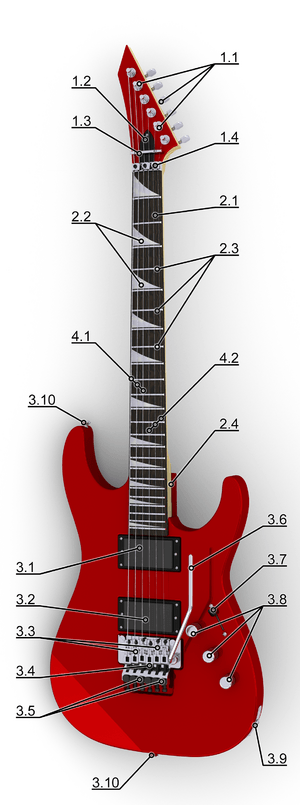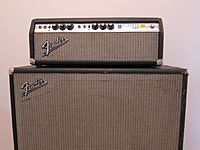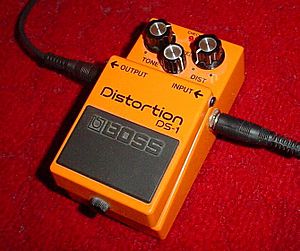Electric guitar facts for kids
The electric guitar is a type of musical instrument. It was invented in 1931 by George Beauchamp. It is a string instrument often played with a pick or sometimes with your fingers.
Electric guitars use special parts called "electric pickups." These pickups are like small magnets wrapped in wire. They turn the vibration of the strings into a tiny electric current. This electric current then goes to an amplifier, which makes it loud enough to hear. The electric current can also be changed to create cool sound effects.
The main parts of an electric guitar are the neck, the pickups, the tuners, the bridge, the input jack, the body, the frets, the pickguard, and the volume and tone knobs. Most electric guitars have one neck with six strings. Some have 12 strings or even more than one neck!
Many companies around the world make and sell guitars. They can be made by hand or in a factory. Some famous electric guitar companies are Fender, Gibson, and Ibanez.
Contents
How to Play the Electric Guitar
Playing the electric guitar can be a lot of fun! Here are some basics to get you started:
- The strings of a guitar are usually tuned to these notes: E, B, G, D, A, E. The thinnest string is the high E, and the thickest is the low E.
- Electric guitars usually have 21, 22, or 24 frets. Frets are the metal strips on the neck.
- As you move your finger up the fretboard towards the guitar body, the notes go up in pitch. Each fret raises the pitch by a small step called a semitone.
- When you first start playing, your fingers might hurt a bit from pressing on the strings. Don't worry! Your skin will get used to it quickly, especially if you practice often.
Understanding Guitar Tablature
Many guitar players share their music using a system called tablature, or 'tab' for short. Tablature is a simple way to read guitar notes. It's easier than reading traditional musical notes. However, most tabs don't show the rhythm of the music. You can find many tabs online or in books and magazines.
To read guitar tab, you'll usually see lines like this:
high E ---------------------------------------------------------------------------------------------
B ---------------------------------------------------------------------------------------------
G ---------------------------------------------------------------------------------------------
D ---------------------------------------------------------------------------------------------
A ---------------------------------------------------------------------------------------------
low E ---------------------------------------------------------------------------------------------
Each line stands for one of the guitar strings. Tab is always read as if you are holding the guitar on your lap, with the strings facing up. Each number on the line tells you which fret to press down on that string.
E -----------------0------------------------------------------------------------------------------------------------------------------
B -----------------0------------------------------------------------------------------------------------------------------------------
G --1-------------1-----------------------------------------------------------------------------------------------------------------
D ----2-----------2-----------------------------------------------------------------------------------------------------------------
A ------2---------2-----------------------------------------------------------------------------------------------------------------
E -----------------0------------------------------------------------------------------------------------------------------------------
The example above shows how to play an open E chord. First, you pick each string one by one. Then, you strum the whole chord. If numbers are stacked directly on top of each other, it means you should strum those notes together as a chord.
Sometimes, guitar music is written using both musical notes and tablature. The musical notes are written out, and the matching tablature is placed right below them.
How Electric Guitars Are Made

1.1 machine heads
1.2 truss rod cover
1.3 string guide
1.4 nut
2. Neck
2.1 fretboard
2.2 inlay fret markers
2.3 frets
2.4 neck joint
3. Body
3.1 "neck" pickup
3.2 "bridge" pickup
3.3 saddles
3.4 bridge
3.5 fine tuners and tailpiece assembly
3.6 whammy bar (vibrato arm)
3.7 pickup selector switch
3.8 volume and tone control knobs
3.9 output connector (output jack)(TS)
3.10 strap buttons
4. Strings
4.1 bass strings
4.2 treble strings
Electric guitars come in many different shapes and designs. But most guitars have some common parts. The picture on the right shows the different parts of an electric guitar.
The headstock (1) is at the top of the neck. It holds the metal machine heads (1.1), which are used to tune the guitar strings. The nut (1.4) is a small strip near the headstock that holds the strings in place. The frets (2.3) are thin metal strips on the fretboard (2.1). When you press a string against a fret, it helps the string make the correct note.
Inside the neck, there's a metal rod called a truss rod (1.2). This rod helps keep the neck straight against the pull of the strings. Small markers (2.2) on the fretboard help players know where they are on the neck.
The neck and fretboard (2.1) connect to the main body of the guitar (3). The body is usually made of wood. When the strings vibrate, the pickups (3.1, 3.2) turn these vibrations into an electric signal. This signal goes through the volume and tone knobs (3.8) and then out through the output jack (3.9) to an amplifier.
Some guitars have a fixed bridge (3.4) that holds the strings. Others have a special bridge with a vibrato bar (3.6), also called a tremolo bar or whammy bar. This bar lets players change the pitch of notes up or down, creating cool bending sounds. A plastic pickguard on some guitars protects the body from scratches when you strum.
The type of wood used for the guitar body can affect its sound. Some common woods are alder, swamp ash, mahogany, and maple. Cheaper guitars might use less expensive woods like plywood. Even though most guitars are made of wood, some are made from plastic, metal, or even cardboard!
The guitar's output jack usually sends a single (mono) signal. Some guitars have special electronics that use a different type of jack for stereo sound. This lets you send the sound from different pickups to separate places, like two different amplifiers.
Guitar Amplifier: Making Sound Louder
An electric guitar needs to be plugged into an amplifier to be heard by an audience. Without an amp, the sound is too quiet.
Guitar amplifiers are different from regular sound systems. Regular amps try to make the sound exactly as it was. But guitar amps often add their own special sound or "color" to the guitar's tone. They can also create a "distorted" or "fuzzy" sound. This unique sound is a big part of a guitarist's style. Many famous guitarists are known for using a specific brand of amp.
In the 1950s and 1960s, guitarists started experimenting with making their guitars sound different. They found that if they turned up the amp's volume (called "gain") very high, the sound would get "fuzzy" or "distorted." This effect is called "clipping" because the sound waves get flattened. This distortion made it easier to play long, sustained notes for guitar solos.
Soon, guitar amp makers started adding ways to create distortion right into the amps. They even made amps with "dirty" (distorted) and "clean" channels, so players could easily switch between sounds. Many guitarists love the warm, rich distortion from vacuum tube amplifiers.
Modern guitar amps often have built-in effects, like bass and treble controls, tremolo, or reverb. Some amps even have many effects like chorus, flanger, and phaser. Guitarists can also use separate effect pedals, called "stompboxes," that they plug into their amp.
Effects Units: Changing Your Sound
In the 1960s, new devices called effect units were invented to change the sound of the electric guitar even more. One of the first was the fuzz pedal.
Effect units usually come in two main types:
- Stompboxes: These are small metal or plastic boxes that sit on the floor. You connect your guitar to them with cables. You turn them on and off with your foot. Each stompbox usually has one or two effects. Many musicians use a "Guitar pedalboard" to organize several stompboxes.
- Rackmount units: These are larger units that fit into special equipment racks. They often contain many different effects. You control them with knobs on the front or with a special digital control system called MIDI.
Here are some common effects:
- Chorus, phaser, and flanger: These effects make the sound swirl, shimmer, or whoosh by slightly changing the pitch.
- Octavers: These effects add notes that are exactly an octave (eight notes) higher or lower than what you're playing.
- Distortion: This makes your guitar sound "fuzzy" or "overdriven," like the classic rock sound.
- Filters: Like the wah-wah pedal, which makes a "wah" sound.
- Envelope shapers: Such as compression, which makes quiet notes louder and loud notes quieter, or volume/swell pedals that slowly fade notes in.
- Time-shift effects: Like delay (echo) and reverb (making the sound seem like it's in a large room).
Images for kids
-
The Fender Stratocaster is a very famous electric guitar shape.
See also
 In Spanish: Guitarra eléctrica para niños
In Spanish: Guitarra eléctrica para niños










